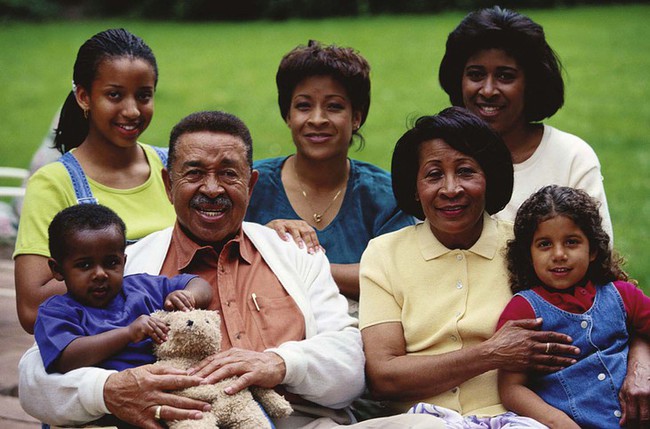Chapter 5 Culture is not biologically inherited. It is learned behaviors transmitted from generation to generation by family members and close friends (Fig. 5-1). These behaviors can be reinforced through social, religious, and school activities. The process of learning the behaviors occurs by osmosis. In other words, the behaviors become absorbed through repetition and positive reinforcement. Parents offer praise to their child when they demonstrate appropriate behavior. When people with different cultural backgrounds meet, learning and growth occur. Acculturation is the process of learning cultural behaviors from one group or person. It is an unconscious fusion of attitudes and beliefs. This does not occur quickly; rather, it occurs over years. Because the United States is a melting pot of many different cultures, acculturation is always occurring. Each cultural group contains many subcultures, which can be as broad and varied as the whole group. The U.S. Census Bureau collects data every 10 years about the population in the United States. Besides population statistics, the bureau also collects data about various races, religions, and ethnic groups in the United States (Table 5-1). TABLE 5-1 Ethnic Groups in the United States *U.S. Census Bureau, 2005-2007 American Community Survey (ACS). Each interaction with a patient will have cultural implications. Below are some examples of conflicts that can occur. Health care workers should keep in mind that these are examples from decades of ethnographic studies and that each patient must be viewed independently (Box 5-1). Americans are focused on healthy living and disease prevention (Box 5-2). The general view is that it is important to eat right, get enough sleep, exercise, and have preventive medical visits (e.g., annual Pap tests, mammograms, immunizations). An illness is seen as interference with one’s schedule, and thus it must be overcome quickly. Other cultures disagree with these beliefs. For example, some American Indian tribes view weight gain as a normal occurrence in adulthood; jogging and aerobic activities are seen as senseless. The ability to communicate has far more importance than language alone. For example, discussions about sexual activity may be considered taboo and insulting to certain cultural groups (Fig. 5-2). Yet other cultural groups, like Americans, are willing to discuss sexual habits and activities more freely. Asking a patient, “When did you have your last bowel movement?” may be appropriate in the United States, but to some cultures discussing elimination patterns is inappropriate.
Culture and Health Care*
 Spell and define the key terms.
Spell and define the key terms.
 Discuss eight specific examples of how cultural differences affect patient care.
Discuss eight specific examples of how cultural differences affect patient care.
 Describe five signs that may indicate a potential cultural barrier exists.
Describe five signs that may indicate a potential cultural barrier exists.
 List seven actions that can overcome cultural obstacles.
List seven actions that can overcome cultural obstacles.
 List at least three culturally sensitive questions for patient care. Explain why each might be sensitive to a patient’s culture.
List at least three culturally sensitive questions for patient care. Explain why each might be sensitive to a patient’s culture.
 Describe at least five guidelines to follow when using an interpreter.
Describe at least five guidelines to follow when using an interpreter.
Cultural Overview
Acculturation
Ethnic Group
Description
% of U.S. Population*
White or Anglo-American
Refers to Western European countries such as England, France, Ireland, and Germany.
75.0
Hispanic or Latino (of any race)
Refers to Puerto Rico, Cuba, Mexico, and South and Central America. The term Chicano generally refers to Mexican descent, and the term Hispanic refers to other Spanish-speaking ancestry.
15.4
Black or African American
Refers to ancestry from any of the countries within the African subcontinent.
12.4
Asian American
Among the 17 Asian subcategories are Bangladeshi, Chinese, Filipino, Hmong, Indonesian, Japanese, Korean, Laotian, Malaysian, Sri Lankan, Taiwanese, Thai, and Vietnamese.
4.4
American Indian (Native American)
The 2000 census data identified 36 tribes in this category, including Apache, Cherokee, Cheyenne, Houma, Navajo, Ottawa, Pueblo, Seminole, and Sioux.
0.8 (Includes Alaskan Native)
Arab American
Includes Egyptian, Iraqi, Jordanian, Lebanese, Moroccan, Palestinian, and Syrian.
*Classified as white American by ACS† 0.3
Native Hawaiian (Pacific Islander)
Refers to Hawaii, Samoa, Guam, and other Pacific Islands.
9.1
Alaskan Native
Includes four main subgroups: Alaskan Athabaskan, Aleut, Eskimo, and Tlingit-Haida.
Included with Native American by ACS
Two or more races
2.3

Cultural Impact on Health Care
Wellness and Health Prevention
Communication
Nurse Key
Fastest Nurse Insight Engine
Get Clinical Tree app for offline access































